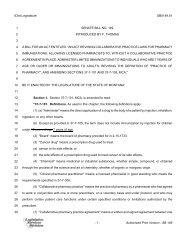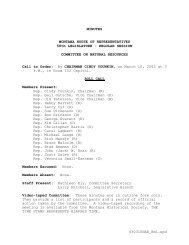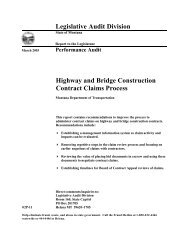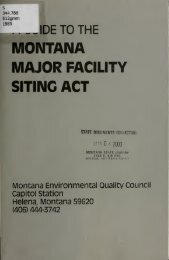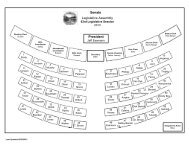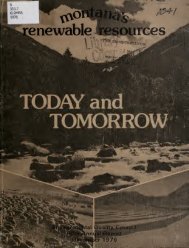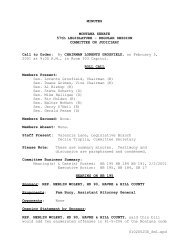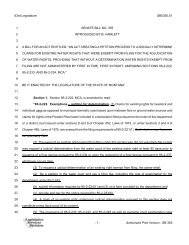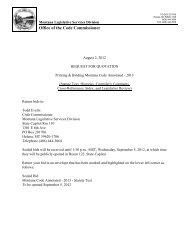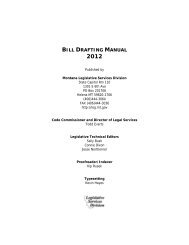Public Comment. Volume III - Montana Legislature
Public Comment. Volume III - Montana Legislature
Public Comment. Volume III - Montana Legislature
You also want an ePaper? Increase the reach of your titles
YUMPU automatically turns print PDFs into web optimized ePapers that Google loves.
, ti AND !l L I P<br />
HOLLAND & HART^^^<br />
AmORNEYS AT LAW<br />
Environmental Quality Council<br />
April 1 1, 2000<br />
Page 2<br />
the stake does not apply to underground coal mining. The prohibition<br />
applicable to surface coal mining.was.tnacted in the early 1970s- when surface .<br />
coal mining was a controversial issue in <strong>Montana</strong>, based in part on the fact that<br />
surface coal mining disturbs a large surface area, which is perhaps some reason<br />
for making the distinction between surface and underground mining, which needs<br />
much less of the surface. Elimination of hard rock mining from the list of<br />
permitted uses for, condemnation would result in owners of minerals being<br />
deprived of their property. Although it sounds simplistic, an ore body must be<br />
mined where it exists; it cannot be moved. If the mining company does not have<br />
the power to take portions of the surface - in every instance paying just<br />
compensation - for location of mills, smelters, tailing ponds and other necessary<br />
adjuncts to the mining process, then it would be impossible to mine. I<br />
respecfilly suggest to the subcommittee that elimination of hard rock mining in<br />
<strong>Montana</strong> is something that should not occur at all, and certainly should not<br />
occur under the guise of a rewriting of the eminent domain laws.<br />
I likewise disagree with the proposal to change the burden of proof in<br />
eminent domain proceedings from "a preponderance of the evidence" to &clear<br />
and convincing." While there are instances under <strong>Montana</strong> law in which clear<br />
and convincing evidence is required in a civil action, they are distinguishable<br />
from most civil actions such as condemnation. For exampIe, a plaintiff must<br />
prove entitlement to punitive damages by clear and convincing evidence,<br />
however, the state recognizes that punitive damages are extraordinary and<br />
require a higher burden of proof for that reason. Likewise, certain actions<br />
involving the welfare of children require a higher degree of proof for obvious<br />
reasons. Further,.none of the civil actions which requires a showing of "clear<br />
and convincing" evidence involves actions by or on behalf of the State in the<br />
public interest, and for uses which have specifically been approved by the<br />
legislature.<br />
Furthermore, .to suggest that uclear and convinciag" is a compromise or<br />
middle ground "between preponderance of the evidence," and "beyond a<br />
reasonable doubt" is inaccurate and misleading. "Beyond a reasonable doubt" is<br />
the standard for burden of proof in criminal cases, and has no relevancy to civil<br />
litigation. Instead of being a middle ground, "clear and convincing" is the<br />
highest standard of proof required in civil actions, and is inappropriate in<br />
eminent domain actions. None of the reasons supporting the exercise of eminent<br />
d~mpjn has changed, and as pointed out earlier in this letter, the exercise of<br />
eminent domain has become less intrusive over time. In fact, no justification is<br />
EQC Eminent Domain Study -1 19-



